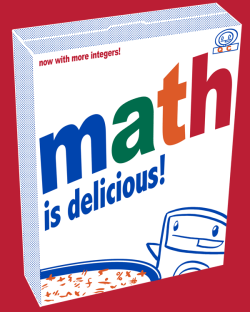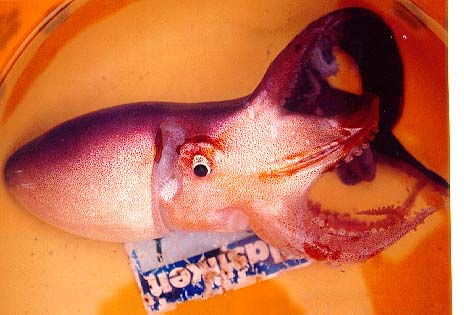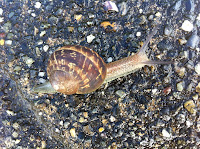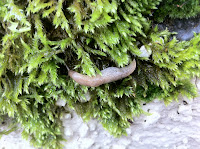Earlier this week I ran into a young man adorning his desk with possibly every book on cephalopods in the university library. Naturally, I had to stop and say hello. He was researching an essay on the evolution of color changes on cephalopods for a poster presentation later in the week. I asked him if he would be kind enough to let me post it here as my posts have been a bit on the scant side as of late. He was gracious enough to agree:
Coleoid Cephalopods: Masters of Masquerade
Will Townshend
University of Glasgow
As with any organism that suffers from predation, methods of protection and self preservation are invaluable. For some, simply escaping by fleeing and evading predators is sufficient or the only method possible to employ. Others adopt means of avoiding detection in the first place. Finally an organism can protect itself by mounting a defense, either by fighting back or by armouring itself. Cephalopods, a class of the mollusc phylum, employ a combination or all of the above.
Coleoid cephalopods, that is the subclass that through evolution, have reduced, internal shells (cuttlefish and squid) or lost it altogether (octopus) take these defensive precautions to unprecedented new levels. Here we will focus on methods of evading initial detection.
Evolutionary pressures for the development of camouflage can be dated back to prehistoric times (around 61mya). With the loss of the defensive hard shell allowing the uptake of a more active lifestyle, coleoids became an easy target for many marine vertebrates such as pliosaurs, plesiosaurs and ichthyosaurs as well as predatory fish, all of which being keen hunters. Icthyosaurs possessing large eyes with high levels of acuity being particularly dangerous, more advanced methods of concealment and camouflage became even more of a precious commodity.
As is the unfortunate case with anything, camouflage comes at a premium and generally has its restrictions. Usually camouflage is fixed or slow changing throughout a day, season or even entire life cycle stages. These restrictions force the organism to inhabit specific environment niches, at the correct time and possibly having to abuse certain specific light conditions. Furthermore, certain behavioural patterns must be adopted such as appropriate postures or orientations of the individual for its camouflage to be effective. Finally organisms with a fixed coloration or pattern often have to face a compromise to fulfil requirements within its natural home environment. By being able to adaptively change their appearance to match their immediate surrounding environment, our colloid cephalopods have evolved to overcome these restrictions.
Chromatophores, specialised cell, are responsible for the ability of an organism to change its colouring and pattern. They are only found in poikilothermic (cold blooded) vertebrates and controlled via cell-cell signalling either hormonally or by neurotransmitters. They are synthesised in neural crest cells during embryonic development and can be divided into 6 subclasses based on hue under white light: Xanthophores - yellows, Erythophores - reds, Iridophores - iridescence, Leucophores - white, Cyanophores - Blues and Melanphores - Black/Browns. These allow for rapid colour change known as metachrosis. Birds and mammals are found to only possess 1 similar cell type called a melanocyte.
Coleoid cephalopods' chromatophores have uniquely evolved further to become neuromuscular organs. Each chromatophore organ contains an elastic sacculus (fluid filled sac) containing pigment which are attached to striated radial muscles, each with nerves and glia. When these muscles contract and relax, the chromatophore expands and contracts changing the what colour is perceived. The size and density depends on the environment, habitat, lifestyle and species while their distribution is in relation to each chromatophore and the surrounding environment. They are controlled by lobes in the brain responding to the optic lobes relaying visual information; the exact understanding of how these brain functions work is not yet fully known. Neural control, both cognitive and reflexive, of the chromatophores allows the cephalopod to change its appearance (colour/pattern) instantly which is key for concealment and evading detection as well as signalling. Chameleons, perhaps one of the creatures most associated with colour change, controls this transformation hormonally and can take as much as 20 seconds to complete the process. An octopus is capable of complete transformation in less than a tenth of that time. Unfortunately, as chromatophores are a soft tissue structures, there is no fossil record of how the evolution of use of colouring and chromatophores actually originally came about in coleoid cephalopods.
Concealment comes under four key points: 1) general background resemblance in matching general colour and pattern, 2) disruptive colouration where the outline of the individual is broken up against its background hindering the search-image formation of predators, 3) deceptive resemblance where colouration and patterning is used to make the individual appear as an inanimate object (eg. rock, seaweed etc.) and finally 4) countershading where by using dark colours on top and light colours underneath gives the perception of a flattening. This is specifically the job of the melanophores, iridophores and especially leucophores which, being broadband reflectors, reflect light of any wavelength over the entire spectrum which incidentally, is also believed to be crucial in the colour/shade matching of colour-blind octopus.
Appropriate countershading is achieved by the use of statocysts. These are endolymph-filled cavities within the cranial cartilage, each containing two areas of sensory epithelium. The macula is a plate of mechanosensory hair cells with an overlaying statolith (mineralised particles) which acts upon the hair cells by accelerating forces (ie. gravity) relaying information to the animal informing it of which way up is. Statocysts allow octopus and cuttlefish to effectively countershade even when disorientated (countershade reflex: CSR).
Control of the chromatophores also enable complex signal communication; deimatic (displays to ward off predators) and agnostic (social behaviour related to fighting eg. for mates, food, territory). These signals can be used for both inter and intraspecfic. Interspecific signals have been documented for hunting to send messages and signals to the prey. An example of this is the "passing cloud" observed in shallow water cuttlefish where it colours itself dark and passes over the target. This helps conceal a tentacle poised ready to strike. Octopus have also been known to exact this strategy as it encourages a camouflaged prey target (eg. crab) to move making it easier to spot and catch. One of the most recorded and documented intraspecific signalling examples is the "Zebra display", again also in shallow water cuttlefish. Modulating strips of high-contrasting colours, usually black and white, creates the visual effect of elongation of the tentacles and increase of overall size. Both these examples have been observed in deimatic and agnostic situations.
The neurally controlled chromatophores possessed by the coleoid cephalopods are especially well adapted for signalling, as not only can rapid signals and rapid signal exchange be conducted but also allows control of intensity of signals leaving potential for even expression of perhaps emotion. Simultaneous bilateral signalling is also possible and is often used during courting periods, where one side will display pale colourings to keep the interest of the prospective female, with more aggressive darker colourings on its opposite side to ward off any rival males (again observed in shallow water cuttlefish). Finally as the chromatophores are independent of other body muscle groups, signalling doesn't interfere with other motor skills. This is particularly important when it comes to hunting in groups such as squid where signals are sent to other members in a group working as a team to coordinate an attack as well as signals to confound their prey.
References:
Allen Justine J, Mathger Lydia M, Buresch Kendra C, Fetchko Thomas, Gardener Meg, Halon Roger T. 2010. Night Vision by Cuttlefish Enables Changeable Camouflage. Marine Resources Center. Brown University. Rhode Island.
Barnes Robert D. 1982. Invertebrate Zoology 4th ed. Holt-Saunders International Ed. Gettysburg College. Pennsylvania.
Boyle P R. 1987. Cephalopod Life Cycles Vol 2 Comparative reviews. Academic Press Inc.
Williams and Maddock. 1995. Cephalopod Neurobiology. Oxford University Press. Oxford. Chapters 21 and 22.
Breidbach O, Kutsch W. 1995. The Nervous Systems Of Invertebrates, An Evolutionary and Comparative Approach.
Cooper, S K. (2002). Chameleons. [Online] Available at: http://magma.nationalgeographic/ngexplorer/0210/articles/mainarticle.html. [accessed: 19/3/12]. National Geographic Society.
Evans David L, Schmidt O Justin. 1990. Insect Defences, Adaptive Mechanisms and Strategies of Prey and Predator. State of New York Press, Albany. Chapter 1.
Kelsh Robert N. 2004. Genetics Evolution of Pigment Patterns in Fish, Pigment Cell Reseach Vol 17. Centre of Regenerative Medicine. Developmental Biology Programme. Department of Biology and Biochemistry. University of Bath. UK
Messenger J B. 2001. Cephalopod Chromatophores: Neurobiology and Natural History. Department of Zoology. Cambridge University. Cambridge.
Ponder Winston F, Lindberg David R. 2008. Phylogeny and Evolution of the Mollusca. University of California Press. California. Chapter 8.
Stevens Martin, Merilaita Sami. 2011. Animal Camouflage Mechanisms and Function. Cambridge University Press. Cambridge University. Cambridge. Chapter 9.
Tosh Colin R, Ruxton Graeme. 2010. Modelling Perception with Artificial Neuron Networks. Cambridge University Press. Cambridge. Chapter 19.
Young J Z. 1964. The Central Nervous System of Nautilus. Department of Anatomy. University College London.
 Look around you! Nature is FULL of
patterns! Fractals (shapes that constantly repeat within themselves) are found
everywhere from broccoli to rivers to the veins in our bodies. The Fibonacci
sequence (golden ratio) is found in sea shells at the beach. Rocks thrown in a
pool will create perfectly shapes circles that behave in predictable ways.
Mathematical formulas are used to describe wind and clouds, acceleration and
deceleration of your car, the symmetry of flowers, etc. Understanding them is
kind of like being able to see the matrix.
Look around you! Nature is FULL of
patterns! Fractals (shapes that constantly repeat within themselves) are found
everywhere from broccoli to rivers to the veins in our bodies. The Fibonacci
sequence (golden ratio) is found in sea shells at the beach. Rocks thrown in a
pool will create perfectly shapes circles that behave in predictable ways.
Mathematical formulas are used to describe wind and clouds, acceleration and
deceleration of your car, the symmetry of flowers, etc. Understanding them is
kind of like being able to see the matrix. 















































